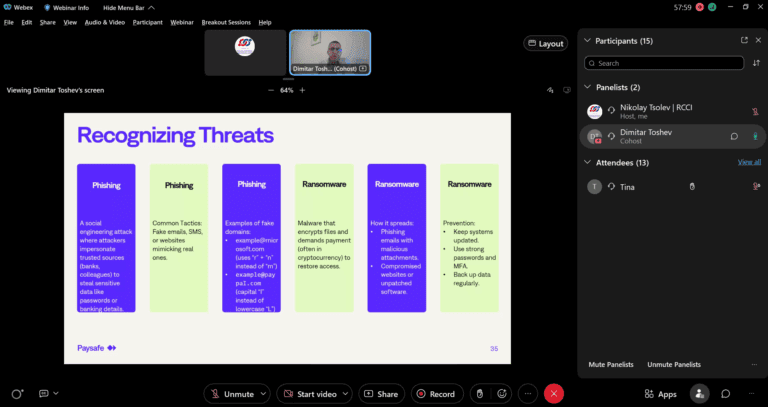Optimizing customer service using big data analytics
In today's digital age, the ability of companies to understand and effectively use available information can transform business operations and provide competitive advantage. Big data analytics plays a central role in this transformation, providing commercial enterprises in Ruse with the opportunity to improve their customer service and accelerate their development. Within the project Be-Digital, this publication examines the application of big data analytics as a tool to improve customer service in the commercial sector.
With the rise of digital technologies and the increasing volume of data, companies in the trade sector are facing new challenges and opportunities. Big data analytics provides valuable insights that can be leveraged across business lines.
Understanding customer behavior and preferences
Understanding customer behaviors and preferences is critical to modern commerce, which strives for personalization and satisfaction of individual needs. Big data analytics allows marketers to gain deep insights into customer behavior patterns that traditional data collection methods cannot provide.
Social media presents a rich picture of customer relationships with brands, highlighting how consumers interact with products and services on a daily basis. This enables companies to recognize and respond to customer opinions and trends in real time.
Online stores, in turn, provide data on customer interests and shopping behavior—which pages attract the most attention, how long users spend browsing certain products, and which product features attract attention or create difficulty.
When combined with information from customer databases, these analytical observations can help businesses identify not only current trends, but also predict future consumer behaviors. This opens the door to creating personalized offerings that meet the specific wants and needs of customers.
The strategy thus created is especially valuable as it leads to greater customer engagement and loyalty. In the long run, this is fundamental to building sustainable and profitable relationships between merchants and their customers.
Personalization of the offer
The personalization of the offer is a key element in the strategy to achieve a competitive advantage in modern commerce. Using big data analytics enables marketers to fine-tune their products and services to precisely meet customer expectations and preferences. This is suitable for eliminating the "one size fits all" mentality and replacing mass supply with highly targeted and tailored solutions.
Data from user interactions and online behavior can be used to build detailed customer profiles. This information is fundamental to developing personalized product recommendations that resonate with individual preferences. For example, based on previous purchases or items viewed, an online store can automatically suggest similar products that would likely interest the customer.
In addition, big data analysis contributes to the personalization of marketing campaigns. Companies can target their ads to those audience segments that are most likely to respond positively to specific offers, based on their previous response to similar campaigns.
Also, data on customer behaviors and preferences can help optimize inventory and logistics by predicting which products will be in greater demand and planning their availability accordingly in certain geographic regions or at certain time periods.
Personalization powered by big data analytics thus becomes a catalyst for increasing customer satisfaction. When consumers see their needs recognized and met in an almost individual way, they develop a deeper sense of brand loyalty, which positively affects sales and business sustainability.
Inventory and supply chain optimization
Big data analytics has become a critical tool for commercial enterprises looking to optimize their inventory management and improve their logistics processes. In the details of the vast amounts of collected data lie valuable insights into consumer demand that can be analyzed to forecast sales and plan product availability more accurately and efficiently.
Using sophisticated algorithms and data processing models, companies are able to analyze historical sales, current market trends, seasonal fluctuations and even forecasted weather data to assess how these factors affect consumption. This allows merchants to respond dynamically to changing market needs, reducing the likelihood of over- or under-stocking, ultimately reducing excess costs and losses.
Additionally, data analytics helps refine supply chain management strategies, which includes not only forecasting inventory needs, but also optimizing transportation, warehousing, and distribution. Inventory management systems exist that automatically order new inventory when inventory drops below a certain level and integrate data from multiple points of sale to ensure constant inventory availability.
Inventory and logistics management, enriched with big data analytics, helps companies reduce redundancies and maintain lower operating costs. This not only increases efficiency, but also improves customer service by reducing product wait times and ensuring better availability of the items they need. With these improvements, merchants can offer more competitive pricing and improve the overall customer experience, leading to greater customer loyalty and repeat purchases.
Refinement of marketing strategies
Improving marketing strategies through big data analytics is transforming the way companies develop and implement their advertising campaigns. Big data analytics provide deep insights into consumer preferences and behavior, allowing marketers to create personalized messages and offers that resonate directly with individual customers' interests and needs.
Based on the processing of huge volumes of heterogeneous data, including customer interaction, purchase history, website behavior and social media, companies can identify not only which products are bought together, but also when and how customers prefer to consume them. This knowledge leads to the optimization of marketing campaigns, which can include targeted ad placement, personalization of email marketing, and the creation of promotional offers that match predictable behavior patterns.
Further, big data analytics facilitates A/B testing and other performance measurement methods, allowing marketers to assess in real time what is working and what is not, and adapt their strategies accordingly. Also, data analytics tools can identify new market niches and expansion opportunities that can take the business in new directions and uncover untapped revenue streams.
The result of refining marketing strategies is higher ROI (return on investment) of marketing campaigns, greater customer engagement and brand strengthening. This leads to the creation of a loyal customer base who not only repeat purchases, but also become brand ambassadors, spreading positive reviews and recommendations.
Conclusion
Big data analysis is a powerful tool for commercial enterprises in Rousse who want to improve their customer service and strengthen their positions in the market. In the context of the Be-Digital project, the research and application of big data analysis becomes a key element in achieving digital transformation in the commercial sector and building a sustainable competitive advantage. This publication was created with the support of the Ruse Chamber of Commerce and Industry and the project Be-Digital, as part of initiatives to improve digital literacy and competence in the region.






